Your customers are the lifeline of your business, and their experience with you is integral to your continued success. This is why customer satisfaction surveys are so important.
Think about why they came to you in the first place; to solve a problem they had. By measuring customer satisfaction, you can identify what is working for them and what isn’t.
What is a customer satisfaction survey?
Customer satisfaction surveys are designed to collect feedback from customers in order to measure the success of different elements of your business.
Opening a line of communication enables you to identify what makes your customers happy and what aspects need improvement.
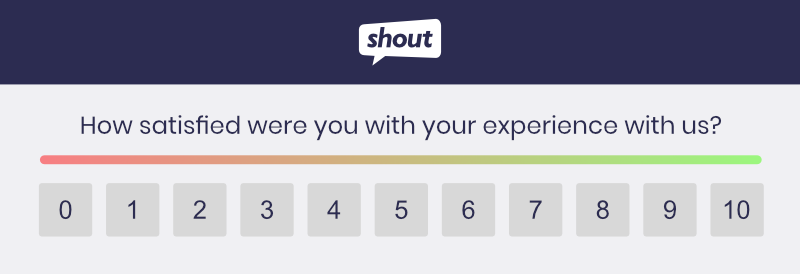
How to measure customer satisfaction
Whilst your customer survey will have a whole range of questions relating to their experience with you, it is possible to measure customer satisfaction by determining your CSAT score. You can do this by asking a single question, but the question type you use will impact how you calculate your score:
- Measuring CSAT with a scale
- Measuring CSAT with a binary question
- Measuring CSAT with a star rating
Measuring CSAT with a scale
To measure your customer satisfaction score with a scaled question type, all you need to ask is:
‘How satisfied were you with the [product/ service] you received?
You can then provide a 1 to 5 (or even 1 to 10) scale:
- Very unsatisfied
- Unsatisfied
- Neutral
- Satisfied
- Very satisfied
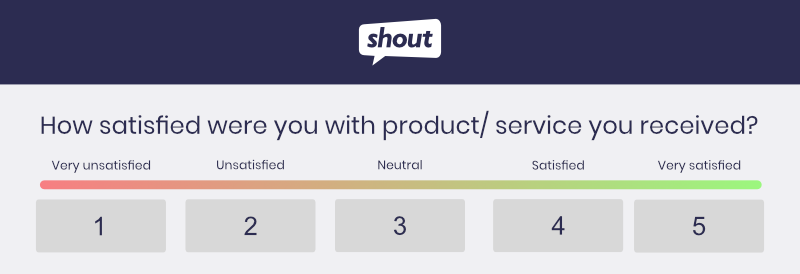
Then, to calculate your score you’ll need to add up all the individual scores given, divide this by the maximum score possible and multiply that number by 100. This will give you your CSAT score as a percentage.
Measuring CSAT with a binary question
Measuring customer satisfaction with a binary (or dichotomous) question only requires two answer choices.
‘Are you satisfied with the [product/ service] you received?’
- Yes
- No
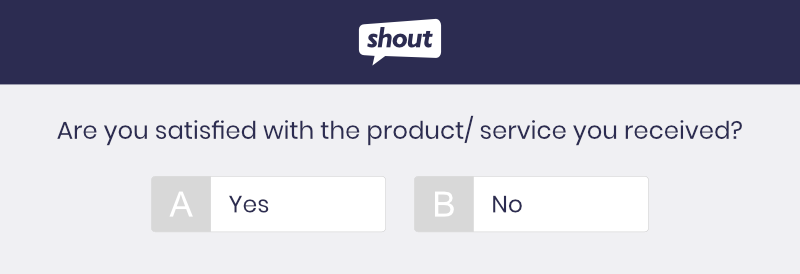
To calculate your CSAT score with this method, you’ll need to divide the total number of positive (‘yes’) responses by the total number of responses received, then multiply this number by 100.
You can also apply this calculation to a scaled question, by dividing all respondents who chose the top two numbers in the scale by the maximum score possible and multiplying that by 100.
Measuring CSAT with a star rating
Star ratings are more general in nature, they’re not usually used to explore specific customer experiences. However, they are useful for giving a more zoomed out perspective of how your customers feel about you.
‘How would you rate your experience with us?’

The calculation for a star rating is as follows; the total number of stars given divided by the maximum number of stars achievable, multiplied by 5 (the total number of stars a respondent is able to award).
Other types of Customer Satisfaction Surveys
Customer satisfaction is directly influenced by their experiences. But there are other types of customer (or client) satisfaction surveys that you can conduct that tell you more about the way they feel about your business.
Two examples of these are Net Promoter Score surveys and Customer Effort Score surveys.
Net Promoter Score (NPS)
NPS surveys are used to determine your customer loyalty. You can quantify this by asking them one simple question:
‘How likely are you to recommend [product/ service] to a friend or colleague?’
To answer this question, customers choose a rating on an 11-point scale (0 to 10), from ‘Not Very Likely At All’ to ‘Extremely Likely’.
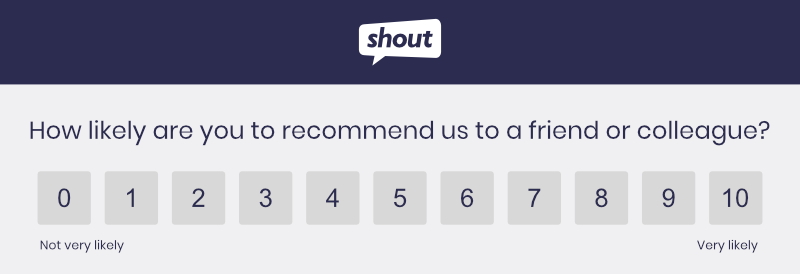
Respondents are split into three categories based on what rating they select along this scale:
0 to 6 = Demoters
7 or 8 = Passives
9 and 10 = Promoters
Calculating your Net Promoter Score
NPS is calculated by subtracting the percentage of detractors from the percentage of promoters. Your final score will be between -100 and 100, where anything over 0 is considered a good score.
Customer Effort Score (CES)
CES surveys are used to measure how easy a specific action or process was for a customer to complete. The purpose of these surveys is to identify areas of friction, so you can remove them and improve customer experience. The types of things you can measure customer effort for are:
- Navigating your website
- Making an online purchase
- Finding resources (e.g. help docs)
- Customer support
Again, you can calculate your customer effort score with a scale (1 to 10) or a binary question (easy or hard). When using a scale, divide the sum of all your CES by the total number of responses.
If you use a binary question, simply subtract the percentage of positive responses from the percentage of negative responses.
When using a neutral answer option, you can ignore this when calculating CES in this way.
Why are Customer Satisfaction Surveys important?
It’s essential that you reach out to your customers for this information because there’s no guarantee they’d get in touch with you if they have an issue. It’s even less likely that customers will get in touch to tell you you’re doing a good job. This same logic applies to your customers sharing their experiences with others.
A survey found that 95% of respondents who had a bad experience shared it with someone they knew. This kind of negative word-of-mouth can be detrimental to generating new leads and customers. These respondents who had a bad experience were also 50% more likely to share their experience on social media and review sites, which can be permanently damaging to your brand.
This is why it’s so important to ask your customers how satisfied they are before an issue snowballs.
Other than avoiding these kinds of nightmare scenarios, there are also major benefits to running customer satisfaction surveys.
- Feedback can be used to improve products and customer experience
- Identify gaps in your product or service
- Discover loyal customers who can become advocates
- Find out why ex-customer switched to a competitor
- Collect testimonials and success stories
1. Feedback can be used to improve products and customer experience
There’s a whole range of things you want to ask customers about your product. Is it good value for money? Did the quality meet their expectations? Was it delivered on time? How does it compare to competitor products they have experience with?
Asking customers these questions shows them you care about their experience and will improve customer retention and loyalty in the long run.
2. Identify gaps in your product or service
Customer feedback isn’t just useful for improving experiences and reducing fiction. It also allows you to identify what’s missing from your product range, your service or even the availability of information.
Customers could be ecstatic with everything you’re doing, but may still go to competitors for features or products that you’re missing. This might not be something you can address immediately, but this kind of feedback gives you the edge when choosing how to expand your business.
3. Discover loyal customers who can become advocates for your brand
While it’s important to know what problems your customers have, it’s equally as important to know what you’re doing well and why. Identifying customers who’re completely satisfied with your products/ service enables you to create customer profiles (buyer personas) for your perfect target audiences.
Not only does this make your marketing efforts easier, but it also provides you with an audience who’s happy and willing to advocate for you.
4. Find out why ex-customers switched to a competitor
You aren’t limited to contacting your existing customer base, there’s real value in collecting feedback from former customers. For example, you can learn:
- The frictions they experienced
- What event or experience incited their exit
- What competitor they chose and why
All of this information is actionable and will help you grow to be a better business with stronger relationships with your existing customers.
On top of this, you have a chance to reclaim ex-customers if you’ve already addressed their issue, whether it was lowering prices, expanding your range, or improving time-to-resolution with customer support.
5. Collect testimonials and success stories
Customer satisfaction surveys are the perfect place to collect testimonials, in-house reviews, success stories and case studies. Even if you don’t collect this information in the survey itself, you can easily identify customers who’ll be happy to provide this social proof.
Content like this is essential to wooing prospects, who’re looking for advice and feedback from people like them. They certainly can’t just take your word for it, by showing proof that you’ve solved their problem for someone else, you’ve laid the foundation for a relationship.
Customer satisfaction question types
- Binary/ dichotomous questions
- Multiple-choice questions
- Opinion scales
- Star ratings
- Open-ended questions
Binary/ dichotomous questions
Binary survey questions provide respondents with two answer options, one positive and the other negative. This could be a simple ‘yes’ and ‘no’, or be more visual like a thumbs up and thumbs down or happy face and sad face.
These question types keep your survey simple and allow you to easily quantify responses into two opposing categories.
However, they don’t provide much information beyond that. On top of this, answering pages of binary questions can be tedious and so respondents may suffer from survey fatigue if your survey is too long. In these cases, respondents are likely to exhibit acquiescence response bias, where they lean towards positive answer options.
Here are a few examples of binary questions:
- Did customer support address all your concerns?
- Are you happy with the product?
- Would you recommend this product?
- Was this article easy to understand?
Multiple-choice questions
Multiple-choice questions usually consist of 3 or more options, where each answer is mutually exclusive from the others.
In customer satisfaction surveys, you can use these question types to categorize themselves based on the options you provide.
For example:
- Job role
- Level of education
- Employment status
- Industry
- Household income
Why is this information relevant to your customer satisfaction feedback? It will allow you to filter your results by demographic information and identify the wants and needs of individual audience segments.
If you’re planning to include more than seven answer options, we’d recommend you use a dropdown list question type instead. Too many options can be overwhelming for respondents, dropdowns package a list of questions in a more appetizing way.
Opinion scales
It’s almost certain that you’ll employ scaled questions in your customer satisfaction survey. Both CSAT and NPS questions require you to use a scale to measure satisfaction and loyalty respectively.
There are three types of scales you can use. The first is a standard numbered opinion scale where respondents select a number, e.g. between 1 and 10. The second is a slider, which also requires respondents to select a number. Both ends of these scales are labelled to provide context to respondents, e.g. ‘Not Very Good’ and ‘Extremely Good’.
The final type is a Likert scale (called a Matrix here on Shout), which are also numbered, but each point along the scale has a label.
Star ratings
Star ratings are simple in their aims, they ask respondents to rate an experience out of a number of stars. These are great for collecting reviews for different products, features or services you provide.
For example, you could use a series of star rating questions to measure satisfaction for:
- Customer support
- Product quality
- Delivery time
Open-ended questions
Open-ended questions are spaces where customers can write customized feedback and are essential to contextualizing your results
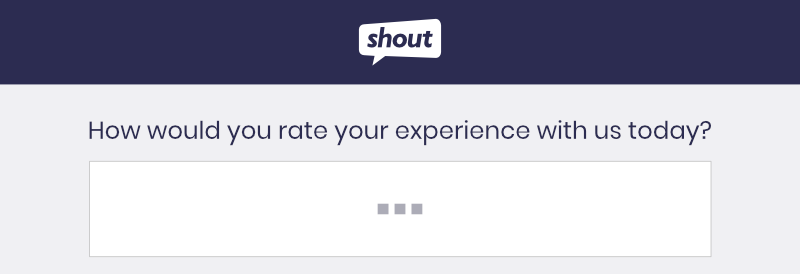
This qualitative data gives you insight into why customers responded a certain way and is the lynchpin for actioning change in your business.
It also ensures that there’s less bias when interpreting your results, allowing you to draw evidence-based conclusions rather than loose inferences.
How often should you survey customer satisfaction?
It can be tempting to ask for customer feedback as often as possible, but this can be counterproductive. Not only will you be drowning through a constant stream of data, you’ll also annoy your customers. This may mean they ignore all future requests for feedback.
We recommend you conduct full customer satisfaction surveys twice a year. This gives you enough time between surveys to act on feedback, so the results are not identical in each survey.
You may also want to avoid sending a full satisfaction survey to newer customers, they may not have enough experience with you to provide actionable feedback.
If you’re having trouble collecting a large enough data set to inform action within your business, take a look at how to increase survey response rates.
Best Practices for customer satisfaction surveys
- Keep surveys short and sweet
- Ask the right questions at the right time
- Ensure questions are neutral
- Test before you send
- Act on results and follow up with customers
1. Keep surveys short and sweet
The longer your survey is, the more likely it is that respondents will suffer from survey fatigue, which can impact your survey completion rate. Before you start writing questions, think about the aim of this particular survey and what data you actually need (right now).
This is for your benefit as much as your respondents. Collecting too much data can be overwhelming, it’s better to collect a more manageable set and action changes one at a time.
2. Ask the right questions at the right time
Following on from our last tip, it’s important to split your surveys up by their context. Not only does this keep them short and targeted, it also ensures you’re collecting the right data at the right time.
For example, if you’re conducting an NPS survey, avoid asking questions about customer effort or satisfaction with individual experiences. You risk muddying your results or skewing respondents’ answer choices when mixing and matching these types of questions.
This is also important as each survey should be used at a different place in the customer journey.
3. Ensure questions are neutral
When writing survey questions, you’ll need to make sure the language you used doesn’t influence the way respondents answer. Loaded language that’s evocative or leading questions that nudge respondents to choose a specific answer will leave you with a useless set of results.
For the best quality data, write questions in a neutral way that encourages customers to express their own opinion.
4. Test before you send
It’s an unfortunate trend in survey research to distribute before testing it yourself. It’s totally understandable that you’ve spent all this time writing the perfect questions for your goal and want to start collecting feedback, but it’s important that you don’t skip this step.
You’ll want to check that your survey is void of any spelling or grammatical error and that all your questions make sense in the context of the survey. Secondly, you can use this opportunity to put yourself in your customers’ shoes to see if there are any biases or order effects induced by the survey.
If you want to go one step further (and we think you should), you can collect some dummy responses from your colleagues or a small pilot group to get an idea of what your feedback will look like.
This gives you the opportunity to chop and change your survey if the results aren’t as useful as you expected.
Finally, it also gives you the opportunity to check the technical elements of your survey. If you’re using an online survey maker, it’s likely you’ll be employing features like Question Logic and Text Piping to personalize survey content. It’s much harder to fix these things if your survey is live and has already collected responses.
5. Act on feedback and follow up with customers
There’s no point collecting all this feedback if you don’t intend to act on it. The only question you need to ask yourself is when and how you will act on it.
You’re going to receive a lot of different opinions and some of them will be contrasting, it’s up to you to decide how much of your audience needs to agree in order for their feedback to create change.
But this isn’t the final step, you should then get in touch with customers to let them know that you acted on their feedback.
This will show them you’ve gone above and beyond to improve their experience and will go a long way in improving customer loyalty and retention.
Wrapping up
So, that’s how to create a customer satisfaction survey. It’s important to keep in mind that it’s impossible to please everyone, we can’t think of a single company that has a 100% customer satisfaction score.
If you can please the vast majority of your audience whilst maintaining your values and mission, you’re doing everything right.




